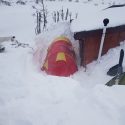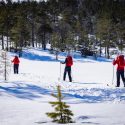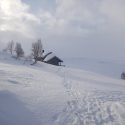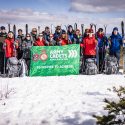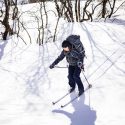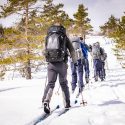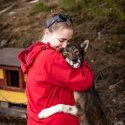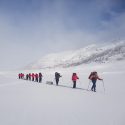Exercise Telemark Challenger was the Army Cadets 2023 premier national Adventurous Training (AT) expedition and our first overseas venture since the relaxation of COVID regulations and travel stabilisation across Europe.
The expedition saw 18 Army Cadets aged 15 plus and 4 Cadet Force Adult Volunteers (CFAVs) from across the UK undertake a 14 day Nordic ski touring adventure conducted in the Telemark region of Norway incorporating Nordic ski training, a journeying element and a battlefield study.
The expedition aimed to provide a diverse group of ACF and CCF(Army) Cadets with a unique and what would normally be an inaccessible opportunity to undertake a challenging journey in an unfamiliar environment. It aimed to develop their personal social skills, teamwork and leadership in accordance the with Army Cadets Adventurous Training rationale.
The concept of operations for Ex Telemark Challenger was to undertake one week of cross country ski training based further south at Evje in the Setesdal valley, then according to skiing ability, split the group into two teams, one to carry out a longer expedition on the Hardangervidda and the other to carry out an additional two days of training before undertaking a shorter journey, supported by a team of huskies. The teams would then reconvene and undertake a re-enactment of the advance to contact carried out by the original saboteurs on the Heavy Water plant at Rjukan. This ensured everyone could fully participate, regardless of their cross country skiing ability, and would be able to undertake an expedition and gain the personal social, teamwork and leadership opportunities that are developed by AT. As anyone who has undertaken cross country skiing wearing rucksacks and pulling pulks will know, high levels of mental and physical robustness are required, especially when weather conditions are poor and the harshness of the environment demands good personal skills, buddy-buddy working and teamwork.
The training phase was completed successfully, blessed with fine weather and good conditions. As well as the skiing, evening lectures introduced the cadets to mountain hazards, avalanche safety, weather conditions, cold weather injuries, survival shelter building and the story of the Heroes of Telemark (HOT) through the medium of the Ray Mears television series broadcast on the BBC some years ago. The cadets then separated themselves into two teams, with the proviso being that our technical experts, the instructors who had been training them, would have a final veto on grounds of skiing competence. However, as is often the case when you give young people responsibility after careful briefing, they made sensible choices and their choice of personnel for each team stood.
Prior to moving north, the long HOT team were then introduced to the specialist equipment they would be using on the expedition while the short HOT team went to meet the husky team that would be supporting them and the musher who owned and ran them.
The next day the long HOT team deployed north to their expedition start point while the short HOT continued their ski training. This was the point at which the one factor that cannot be planned for in advance kicked in: the weather! Dynamic risk management came to the fore, the weather forecast indicated the possibility of severe weather, plummeting temperatures, strong winds and heavy snow to come for the week ahead. This could have potentially serious implications and led to some swift planning to ensure the safety of both teams. The route for the long HOT was adjusted to keep them away from steep avalanche prone terrain and the decision was made not to launch the short HOT directly over the plateau. This was to avoid the possibility of bad weather trapping the teams on the plateau.
Having been introduced to all the expedition equipment, the short HOT team deployed north to a central base where they could undertake day tours on some of the resupply routes used by the saboteurs supported by their husky team and theirs pulks. The long HOT team deployed by snow scooter to one of the huts used by the original saboteurs, Fjaerefit Hytte and the following day, in overcast challenging conditions, skied to Berunten Hytte. Overnight, 40cm of snow fell making off piste skiing difficult and increasing the risk of avalanche on all aspects of slope. Instead of journeying to the next hut, the team went onto the plateau to experience the conditions and gain an understanding of dynamic decision making before returning to the hut. A further 50cm of snow fell again overnight and the following day the team took a safe route across the plateau to a newly organised hut at a lower altitude. There, they overnighted before making their way to the final RV.
For the final stage of the expedition, both teams came together again and moved into a lodge with fantastic views over the Hardangervidda. There, they were briefed on the final advance to contact down into Rjukan which was led by an ex Norwegian Army Colonel who was an expert on Op GUNNERSIDE. The next day, now in snowshoes due to heavy snow fall, they retraced the exact route taken by the saboteurs to attack Rjukan, stopping at relevant places to be briefed on what had happened by the Colonel. It was a fascinating exercise, ending up with a visit to the museum dedicated to the Heroes of Telemark based in the actual Heavy Water factory building at what is now a hydroelectric plant.
After a final dinner in the lodge, everyone was presented with the Snowsport Awards they had achieved and certificates recording their participation in the Heroes of Telemark re-enactment. It was a fitting finale to an excellent expedition which had given everyone an opportunity to understand the resilience, bravery, teamwork and leadership which enabled the original saboteurs to achieve their mission. Being able to follow in the footsteps of the Heroes of Telemark added realism to the requirement to work together as a team and the constantly changing and challenging weather conditions emphasised this almost through necessary.
For some of the participants this was the first time they had ever stepped foot outside the UK or travelled by aeroplane. None of the cadets had ever visited Norway before with less than half of them having ever put a set of skis on previously.
What you cannot measure is the personal development that occurs when you take a group of young people from all over the UK with very different social and economic backgrounds and place them together in a new and challenging environment with a common goal. It enables the growth of social skills, verbal communications, consideration for others, selfless commitment to the team, the task and, for many, personal confidence.
It is so important that we never lose sight of the fact that adventurous activities and expeditions with their many fringe benefits such as overseas travel and learning new skills are primarily a vehicle for the development of our young peoples’ personal social skills, teamwork and leadership all of which are valuable and transferable life skills.
This expedition would not have been possible without the financial support from the Ulysses Trust, we are very grateful for your generosity This grant ensured this expedition was open to all cadets whatever their financial situation.
Quotes from Emma Whillis – Heaton Detachment.
“Started today feeling confident but the weather conditions made the day far more difficult than I expected. I quickly realised the importance of working as a team and the need to be aware of others rather than plodding on in our own little world.
“I feel so privileged to have been chosen to take part in such an amazing opportunity and experience. Each day I have gained more and more respect for the physical and mental strength, and resilience of the original saboteurs.
“Re-enacting the final assault on the heavy water plant, walking around the Museum and watching the video at the hydroelectric plant really jarred me. I can’t imagine how people must have felt to be occupied under such a regime.”
The Ulysses Trust also wish to thank the generosity of Army Sport for supporting this expedition britisharmysport.com

